In the dynamic world of digital advertising, staying ahead of the curve is not just an advantage; it’s a necessity. For businesses leveraging the power of Google Ads, one metric has increasingly become a focal point for campaign management and success: the Google Ads optimization score. This powerful, yet often misunderstood, feature is your real-time guide to fine-tuning campaigns for maximum efficiency and return on investment (ROI). But what exactly is this score, and how can you leverage it to transform your advertising efforts from good to great?
This comprehensive guide will delve deep into the mechanics of the Google Ads optimization score. We will explore its components, understand its significance, and provide actionable strategies to improve it. Whether you are a novice just starting or a seasoned Google Ads expert, mastering your optimization score is a critical step towards advertising excellence. For a foundational understanding of Google Ads, consider visiting our cornerstone article at Google Ads Secrets.
What is the Google Ads Optimization Score?
The Google Ads optimization score is a diagnostic tool provided by Google that estimates how well your account is set to perform. It’s represented as a percentage from 0% to 100%, with 100% indicating that your account is structured to perform at its full potential according to Google’s best practices. The score is calculated in real-time and is available at the campaign, account, and manager account levels.
Think of it as a free, built-in consultant that constantly analyzes your account and provides recommendations for improvement. These recommendations are tailored to your specific campaigns and are designed to help you get more out of your budget. Each recommendation shows how much your optimization score will increase (in percentage points) if you adopt it. These suggestions cover various aspects of your account, including bids and budgets, keywords and targeting, ads and extensions, and more.
It is crucial, however, to differentiate the optimization score from the Quality Score. While both are vital metrics, they serve different purposes. Quality Score is a diagnostic tool at the keyword level, measuring the quality of your ads, keywords, and landing pages. In contrast, the optimization score provides a more holistic view of your entire account’s health and potential performance.
Why is the Optimization Score So Important?
Ignoring your Google Ads optimization score is like driving a car with the check engine light on. You might still get to your destination, but you’re likely wasting fuel and risking a breakdown. A high optimization score is correlated with better campaign performance, improved ROI, and a more efficient use of your advertising spend.
1. Enhanced Performance and ROI
The recommendations provided by Google are based on vast amounts of data and sophisticated machine learning models. By implementing these suggestions, you align your campaigns with proven strategies that can lead to higher click-through rates (CTR), better conversion rates, and a lower cost-per-acquisition (CPA). Ultimately, this translates to a healthier bottom line. Understanding your key metrics is the first step to improving them.
2. Proactive Problem Solving
The optimization score helps you identify and fix issues before they escalate. It can alert you to problems like ad groups without ads, conflicting negative keywords, or campaigns limited by budget. By proactively addressing these issues, you ensure your campaigns are always running smoothly and efficiently. This proactive approach can be the difference between a campaign that thrives and one that merely survives.
3. Staying Current with Google’s Best Practices
The digital advertising landscape is constantly evolving. Google frequently introduces new features, bidding strategies, and ad formats. The optimization score and its recommendations help you stay up-to-date with these changes, ensuring your account is always leveraging the latest and most effective tools available. For instance, understanding recent updates like the “Consist Mode” update is crucial for modern campaign management.
4. Strategic Time Savings
Manually auditing a large Google Ads account can be a time-consuming and complex task. The optimization score automates much of this process, quickly highlighting the most impactful areas for improvement. This allows you to focus your time and energy on strategic initiatives rather than getting bogged down in routine checks. For those looking to save even more time, exploring automated scripts can be a game-changer.

How to Improve Your Google Ads Optimization Score: A Step-by-Step Guide
Improving your optimization score is not about blindly accepting every recommendation Google throws your way. It’s about critically evaluating each suggestion and understanding how it aligns with your specific business goals. Here’s a strategic approach to boosting your score.
Your journey begins on the “Recommendations” page in your Google Ads dashboard. Here, you’ll find your overall optimization score and a list of specific, actionable recommendations. The page is designed to be intuitive, categorizing suggestions for easy navigation. Before making any changes, it’s wise to audit your ad account thoroughly to understand its current state.
Step 2: Analyze and Prioritize Recommendations
Each recommendation comes with a score uplift value. This number indicates how much your score will improve if you implement the suggestion. While it might be tempting to tackle the highest-value recommendations first, it’s essential to prioritize based on a combination of score uplift and business impact. Ask yourself: “Will this recommendation help me achieve my primary advertising objectives?” Some recommendations, like adopting a new bidding strategy, might have a significant impact, while others, like adding new keywords, require more careful consideration to avoid issues like attracting high impressions with zero clicks.
Step 3: Implement or Dismiss with Justification
Once you’ve decided on a recommendation, you can apply it with a single click. However, not every recommendation will be a good fit. For example, Google might suggest a broad match keyword that isn’t relevant to your business or a budget increase that you can’t afford. In these cases, it’s important to dismiss the recommendation. When you dismiss a suggestion, Google will ask for a reason. Providing this feedback helps the system learn and offer more relevant recommendations in the future. Remember, you are the expert on your business. For insights from other experts, you can explore resources like HubSpot’s blog or Neil Patel’s extensive guides.
Common Recommendation Categories and How to Approach Them
Bids & Budgets
- Automated Bidding: If you have sufficient conversion data, switching to an automated bidding strategy can be highly effective. It allows Google’s algorithm to set bids in real-time to optimize for your goals.
- Budget Adjustments: If a profitable campaign is limited by budget, increasing it is often a wise move. However, if the campaign’s profitability is borderline, you should analyze its performance further before committing more funds.
Keywords & Targeting
- New Keywords: Always research suggested keywords before adding them. Ensure they are relevant to your offerings and have a clear user intent. The power of using nouns over verbs in search keywords can be a subtle but powerful tactic.
- Negative Keywords: This is a critical area. Regularly add negative keywords to filter out irrelevant traffic. This is one of the most effective ways to improve campaign efficiency. Be wary of irrelevant close variants that can drain your budget; a specialized script can help manage this.
- Targeting Expansion: Recommendations to expand to the Display Network or Search Partners should be approached with caution. While they can increase reach, they often have lower conversion rates. Monitor performance closely if you enable these options.
Ads & Extensions
- Ad Variations: A/B testing different ad copy is fundamental. Always have at least two or three ads per ad group to see what resonates best with your audience. You can even run scripts to pin specific headlines for promotions.
- Responsive Search Ads: RSAs are now the default ad type. Provide as many unique headlines and descriptions as possible to give Google’s machine learning the flexibility to create the most effective ad combinations.
- Ad Extensions: These are non-negotiable. Implement every ad extension that is relevant to your business (sitelinks, callouts, structured snippets, call extensions, etc.). They increase your ad’s visibility on the SERP and provide users with more information, often leading to a higher CTR.

Beyond the Score: A Holistic Approach to Optimization
While the optimization score is a fantastic tool, it’s not the be-all and end-all of Google Ads management. A 100% score doesn’t guarantee success if your underlying strategy is flawed. True optimization requires a blend of leveraging Google’s automation and applying human strategic oversight.
The Importance of Landing Pages
Google’s recommendations stop at the click. But a successful campaign follows the user all the way to conversion. Your landing page experience is a massive factor in your actual ROI. Ensure your landing pages are mobile-friendly, load quickly, and have a clear call-to-action that aligns with your ad copy. Deciding between a Google My Business profile and a dedicated landing page depends on your campaign’s goals.
Connecting with SEO
Your paid search efforts don’t exist in a vacuum. A strong SEO strategy can complement your Google Ads campaigns. High-ranking organic content can inform your keyword strategy, and insights from PPC data can highlight lucrative topics for SEO. Many principles overlap, and understanding how SEO and PPC work together is crucial. For in-depth SEO knowledge, platforms like Moz and Search Engine Journal are invaluable resources.
Continuous Learning and Adaptation
The best advertisers are perpetual students. The digital marketing world is always in flux. Dedicate time to learning from industry blogs like Marketing Land, participating in forums like Reddit‘s PPC communities, and asking questions on platforms like Quora. For formal education, consider courses from Coursera, Udemy, or for Arabic speakers, Edraak.
Localizing Your Efforts
For businesses targeting specific regions, especially in diverse markets like the Middle East, localization is key. This goes beyond just translating keywords. It involves understanding local culture, search behavior, and leveraging local directories. For Arabic-speaking countries, listing your business on platforms like ArabiaSEO, Arab Directory, and Yellow Pages UAE can significantly boost local relevance and trust.
Conclusion
The Google Ads optimization score is more than just a number; it’s a compass guiding you toward a more efficient and profitable advertising strategy. By understanding its components, critically evaluating its recommendations, and integrating them into a holistic marketing approach, you can unlock significant performance gains. It empowers advertisers to work smarter, not just harder, by automating routine checks and highlighting high-impact opportunities.
However, remember that automation is a tool, not a replacement for human expertise and strategic thinking. Use the optimization score as your guide, but always filter its advice through the lens of your unique business goals and market knowledge. From setting up your initial campaigns to diving into advanced Google Ads tips, the journey of optimization is continuous. For personalized advice, consider a general consultation to take your campaigns to the next level.
Embrace the optimization score, combine it with your strategic insights, and watch your Google Ads performance soar. If you have questions or need expert assistance, don’t hesitate to reach out to a professional like Hisham Ezzat or contact us directly via WhatsApp.
Frequently Asked Questions (FAQ)
1. How often does the Google Ads optimization score update?
The optimization score updates in real-time. As you make changes to your account or as Google’s system identifies new opportunities, your score will adjust accordingly. It’s a dynamic metric that reflects the current state of your account’s potential.
2. Is a 100% optimization score always achievable or necessary?
Achieving a 100% score is possible, but it shouldn’t be the ultimate goal at the expense of your business strategy. It’s more important to have a high score that reflects a healthy, well-managed account that aligns with your specific objectives. Sometimes, a recommendation that would increase your score might not be right for your business. In such cases, it’s better to dismiss the recommendation and have a slightly lower score than to implement a change that hurts your performance.
3. Does optimization score directly impact my Ad Rank or Quality Score?
No, the optimization score does not directly impact your Ad Rank or Quality Score. It is a separate, diagnostic tool. However, many of the recommendations for improving your optimization score—such as improving ad relevance, using ad extensions, and enhancing CTR—are factors that do positively influence your Quality Score and, by extension, your Ad Rank. So, improving your optimization score often leads to indirect improvements in these other critical metrics.
4. Can I improve my optimization score without spending more money?
Absolutely. Many recommendations are not related to increasing your budget. Suggestions to add negative keywords, pause underperforming keywords, improve ad copy, add extensions, or remove redundant keywords can all improve your score and campaign efficiency without requiring additional spend. You can even find free tools to help, such as the free SEO tools from Moz, which can give you keyword and market insights.
5. Where can I find more resources to learn about Google Ads?
There are many excellent resources available. For a deep dive into practical strategies and expert advice, exploring a dedicated resource like the Google Ads Secrets blog is a great starting point. Industry-leading marketing blogs and forums are also invaluable for staying current and learning from the community.



